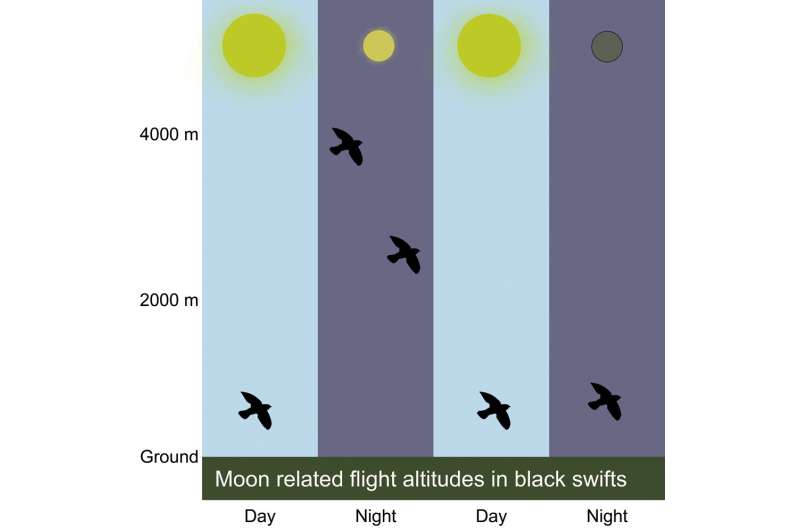Graphical abstract. Credit: Current Biology (2022). DOI: 10.1016/j.cub.2022.03.006
An international research team led by Lund University in Sweden has managed to study the flight behavior of the mysterious black swift. They found, among other things, that the black swift rises to extreme heights during a full moon, seemingly catching insects in the moonlight. And, during a lunar eclipse, the birds simultaneously lost altitude. The results are published in Current Biology.
The black swift is a bird species with a bulky body and long, pointed wings. The plumage is black with some white areas on its head, and its call is a series of high-pitched tweets, with the occasional longer squeak. The black swift is endangered, and has therefore long been of great interest to the world's bird researchers.
Using microdata loggers and advanced technology, the researchers were able to map the movement patterns of black swifts during their migration from the Rocky Mountains in Colorado to the Amazon Basin in Brazil.
"We discovered that the black swift does not land a single time during their eight and a half month long migration, so they stay in the air the entire time," says Anders Hedenström, biologist at Lund University.
When the researchers went through the material, they made another discovery that surprised them. It turned out that the black swifts, in connection with a full moon, rose to extreme heights at night. While flying at an altitude of a few hundred meters in daytime, during full moon nights they rose to between 2000 and 4000 meters.
"The dynamics of the high-altitude flight in relation to the different phases of the moon came as a total surprise to us," says Anders Hedenström.
The researchers also managed, by chance, to study the birds in connection with a lunar eclipse—when all the birds reacted instantaneously by diving to much lower altitudes. The moonlight thus has a direct significance for the black swifts' flight altitude.
"Our results are very exciting, and reminiscent of the vertical movements in relation to moonlight found in, for example, zooplankton in the oceans," says Anders Hedenström.
More information: Anders Hedenström et al, Moonlight drives nocturnal vertical flight dynamics in black swifts, Current Biology (2022). DOI: 10.1016/j.cub.2022.03.006
Journal information: Current Biology
Provided by Lund University
























